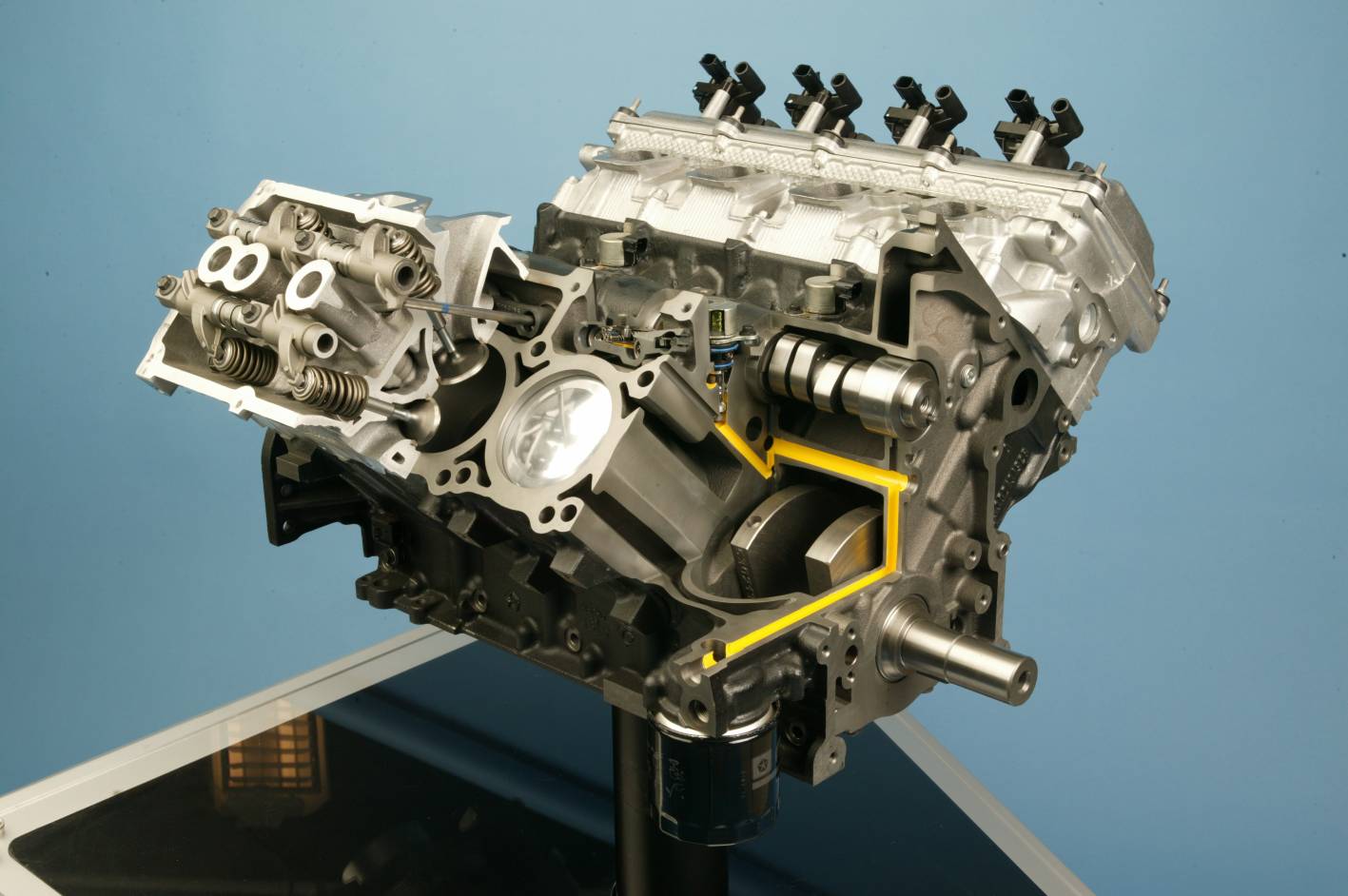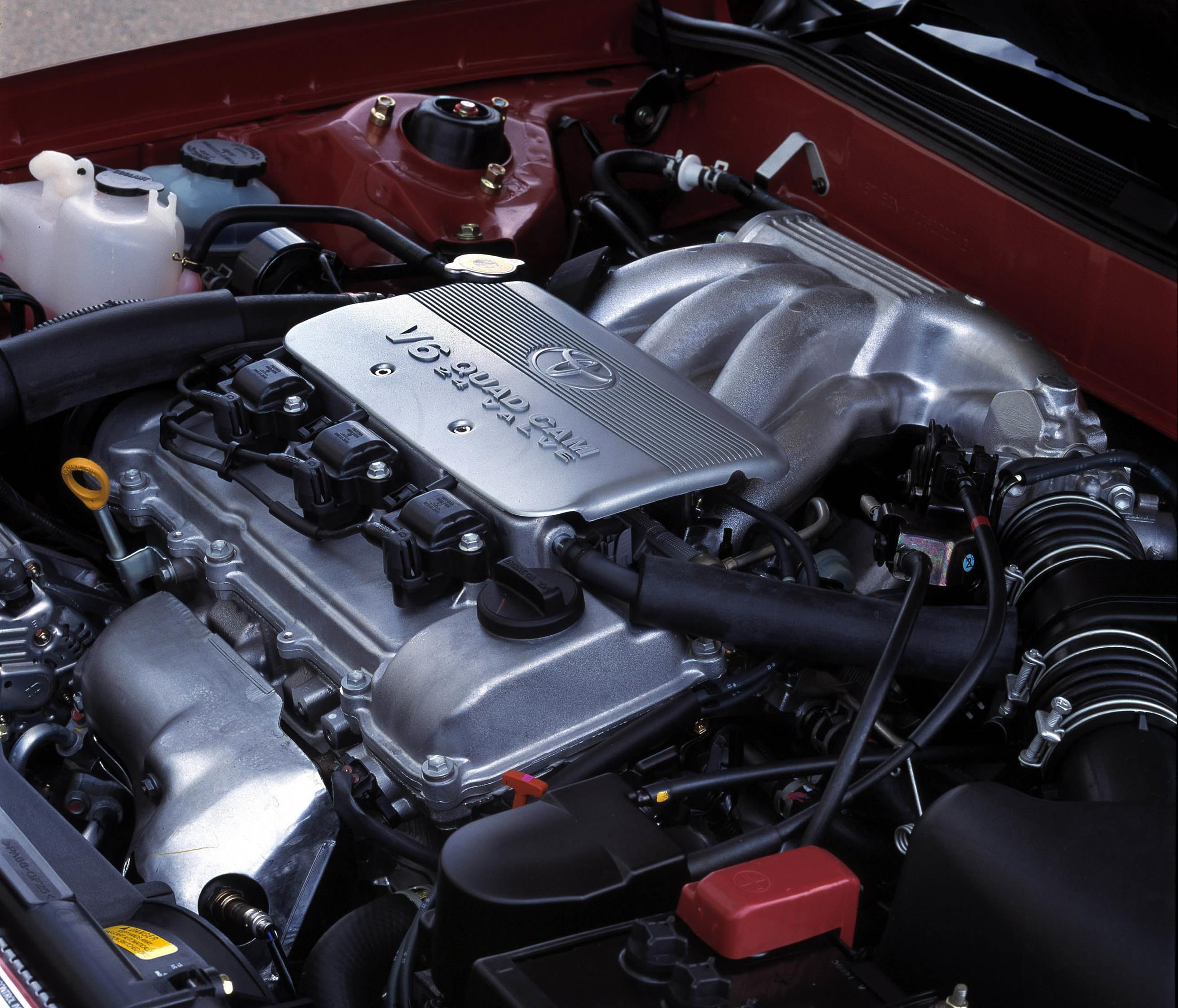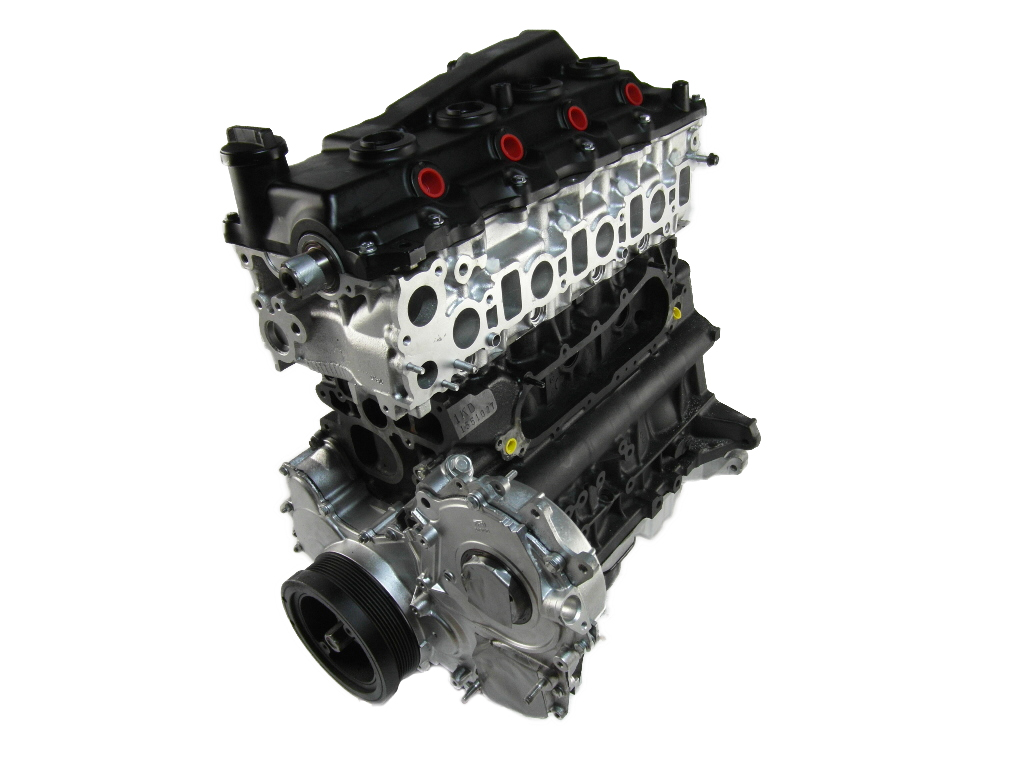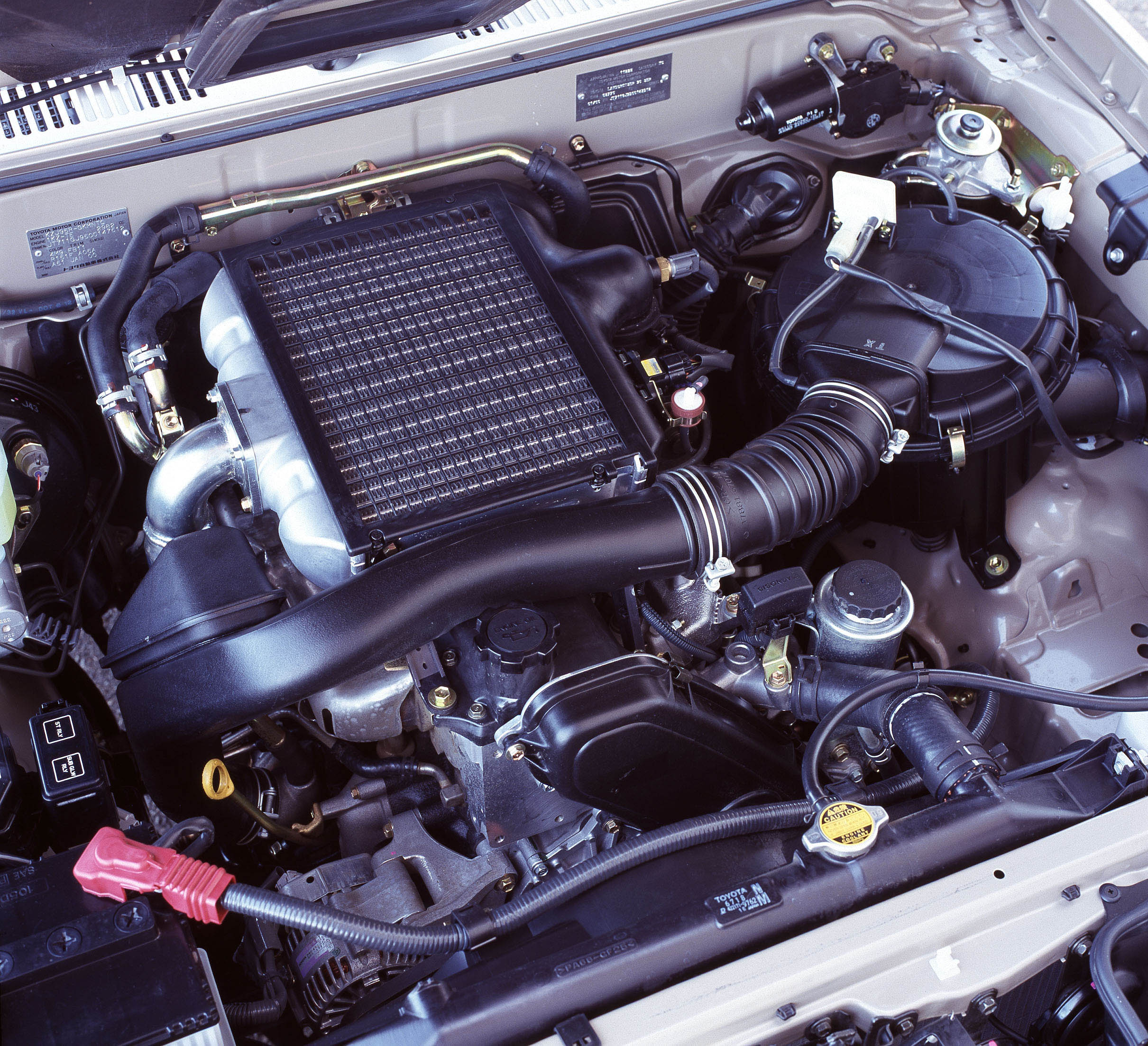Introduction
Chrysler’s EZB engine was a member of the 5.7L HEMI V8 engine family that was produced from 2003 to 2009 and powered vehicles such as the Chrysler LX 300C and Jeep WH Grand Cherokee (see table below). Producedat Chrysler’s Saltillo Engine plant in Ramos Arizpe, Mexico, key features of the 5.7L HEMI V8 engine included its:
- Deep-skirt, grey cast-iron block with a 90-degree ‘V’ and open-deck design;
- Nodular cast iron crankshaft;
- Mahle cast eutectic alloy pistons with domed crowns;
- Cast aluminium alloy cylinder head;
- 2 valves per cylinder actuated by pushrods;
- Multi-Displacement System for cylinder deactivation;
- Compression ratio of 9.6:1;
- Two spark plugs per cylinder; and,
- Maximum engine speed of 5800 rpm (electronically limited).
Furthermore, the EZB engine had a mass of 242 kg.
For simplicity, this article will refer to the EZB engine as the 5.7L HEMI V8 engine.
| Model | Engine | Trans. | Peak power | Peak torque |
|---|---|---|---|---|
| Chrysler LX 300C | 5.7-litre EZB petrol V8 | 5sp auto | 250kW at 5000rpm | 525Nm at 4000rpm |
| Jeep WH Grand Cherokee | 5.7-litre EZB petrol V8 | 5sp auto | 250kW at 5000rpm | 525Nm at 4000rpm |
Block
The 5.7L HEMI V8 engine had a deep-skirt, grey cast-iron block (53021319AC/AG/CB casting) with an open-deck design that required large deck surface openings for easy sand removal after casting since the block did not have core plugs (to prevent coolant leaks). The 5.7L HEMI V8 engine had 99.5 mm bores spaced at 113.3 mm intervals and a 90.9 mm stroke for a capacity of 5654 cc. The cylinder banks formed a 90 degree ‘V’ angle and had a 22.4 mm offset.
The front cover of the 5.7L HEMI V8 engine was made from die-cast A380 aluminium and sealed the front of the block and sump; the alternator, water pump, air-conditioning compressor, power steering pump and belt idler were all mounted on the cover. The HEMI V8 engine was 523 mm long and had a deck height of 235 mm.
In designing the HEMI V8, Chrysler employed computer aided engineering (CAE) to make the block as light as possible (despite being made from cast iron). Chrysler also adopted a ‘no touch’ principle whereby no finished surface was to require further work once it had been machined or ground.
All modern HEMI V8 engines were designed for MDS and had four holes in the valley of the engine block. While engines with MDS had a solenoid in this plug, those without had a plastic plug instead.
Crankshaft
The crankshaft for the 5.7L HEMI V8 engine was cast from nodular iron (53021300AA casting) and had deep-rolled undercut fillets to improve fatigue strength. The crankshaft was supported by five main bearings, each of which had four bolts (two vertical and two horizontal). Furthermore, the main bearing caps were made from powder metal and used cross-bolting with a single M8 bolt each side.
For the 5.7L HEMI V8 engine, the crankshaft had three bolt holes in a circular pattern for the crank sensor that was located behind the last counterweight. However, Chrysler did not supply crank sensors separately because the crankshaft was balanced with the sensor on it and Chrysler claimed that balance would be adversely affected if the crank sensor was changed. Owners therefore had to purchase a new crankshaft (with sensor) if the original sensor failed.
The main crankshaft journals had a 65 mm diameter, while the small-end journals had a 54 mm diameter. Furthermore, a vibration damper was press-fitted on the nose of the crankshaft.
Connecting rods
For the 5.7L HEMI V8 engine, the connecting rods were manufactured from powdered metal and had cracked big-ends. Each connecting rod was 158.5 mm long and had a mass of 597 grams +/- 5 grams (including the bolts). The connecting rod was attached to the piston by a press-fitted gudgeon pin.
Pistons
The pistons for the 5.7L HEMI V8 engine were manufactured by Mahle and cast from eutectic alloy. The pistons had slightly domed crowns, while the piston skirts were coated with Grafal (a graphite-based coating) to reduce friction. Each piston had a mass of 413 grams.
The 5.7L HEMI V8 engine had narrow piston rings are narrow (1.5 mm/1.5 mm/3.0 mm) and the ring pack was located close to the top of the piston. The top land was positioned within 3.0 mm of the crown to reduce crevice volume and emissions; to withstand heat and pressure, the top ring groove was hard anodized. Beneath the top ring, there was a reservoir groove to reduce pressure between the top and second ring.
Cylinder head
The cylinder heads for the 5.7L HEMI V8 engine were cast from A319F aluminium alloy and each had a mass of approximately 13.6 kg (per cylinder bank). The cylinder heads were mounted on a three-layer stainless steel gasket – which had a compressed thickness of 0.7 mm – and bolted to the block using M12 bolts around the bores and M8 bolts near the intake manifold.
Chrysler used computer aided engineering (CAE) to optimise coolant flow within the heads. The coolant flow followed a ‘U’ path which began at the rear of each cylinder head and exited at the front into the cylinder block. As a result of computational fluid dynamics (CFD) analysis, fillets and ribs were added to the internal head coolant passages so that higher velocity flows occurred in critical cooling zones. Furthermore, the engine had a wide valve bridge to maintain adequate cooling flow – this was considered important for truck applications where high loads may be required over prolonged periods
It is understood that exhaust gas recirculation holes were drilled in the cylinder head from late 2003.
Camshaft, pushrods and valves
For the 5.7L HEMI V8 engine, the camshaft was positioned high in the cylinder block to minimise the length of the pushrods, though shorter pushrods were used for the intake valves relative to the exhaust valves. While the cams for the 5.7L HEMI V8 engine originally had a hollow assembled design, it is understood that cast iron and billet steel versions were subsequently used. To minimise side loading on the roller-style valve lifters, the cam had oversized journals and lobes.
The 5.7L HEMI V8 engine had two valves per cylinder with eight deactivating and eight conventional hydraulic lifters, all with roller followers. Specifications for the valves were as follows –
- Intake valve diameter (head): 50.8 mm;
- Exhaust valve diameter (head): 39.4 mm;
- Intake valve lift: 12.0 mm;
- Exhaust valve lift: 11.7 mm;
- Inlet valve flow at 6.2 kPa pressure differential: 118 litres per second;
- Exhaust valve flow at 6.2 kPa pressure differential: 85 litres per second; and,
- Included valve angle: 34.5 degrees.
Furthermore, the valve seats and valve guides were made from powdered metal.
The lifters were oiled via the pushrods whereby oil circulated:
- From the pump to the cam bearings; then,
- Up through the cylinder heads to the rocker shafts; and then,
- Through the rockers and down the pushrods to the lifters.
As a result, the oil passages in the valley of the engine block could be used to deactivate the MDS lifters. Furthermore, the pushrods provided a reservoir of oil to prevent lifter noise at start up.
The 5.7L HEMI V8 engine had beehive-type valve springs which, compared to conventional springs:
- Reduced the top coil of the spring for a lighter retainer; and,
- Enabled stress to be equally distributed on opposing sides of the wire.
The 5.7L HEMI V8 engine had 253 degrees of intake duration and 253.7 degrees of exhaust duration at 0.006″ with 34 degrees of overlap.
Multi-Displacement System (MDS)
The 5.7L HEMI V8 engine had a ‘Multi-Displacement System’ (MDS) which enabled the engine to switch from eight to four cylinder operation. The MDS system used a separate oil gallery in the valley of the block and four solenoids to apply pressure to the pins in the sides of the deactivating valve lifters in cylinders 1, 4, 6 and 7. Furthermore, the fuel injectors were shut off.
When disabled, the lifter body continued to go up and down, but the plunger inside the lifter remained stationary so that the valves stayed closed. The exhaust gases trapped in each cylinder were compressed on the compression and exhaust strokes so that they helped push the pistons back down on the intake and power strokes. The ECU could activate and deactivate the MDS solenoids in 40 milliseconds.
According to Chrysler, the MDS system in the Chrysler LX 300C provided ‘estimated fuel economy gains of up to 20 per cent under various driving conditions, and a projected 10 per cent aggregate improvement.’
Intake
The intake manifold assembly (‘Integrated Air Fuel Module’) was made from a plastic composite (Nylon 6) and contained the injectors, an 80 mm diameter electronic throttle butterfly, an intake manifold, sound-damping cover, the PCV system, MAP sensor and engine wiring harness.
Plenum volume was 11.3 litres, while the intake runners were 273 mm long and tapered from a diameter of 50 mm at the plenum to 43 mm at the heads. To reduce noise, vibration and harshness, the intake assembly had:
- A three-chamber Helmholtz intake resonator;
- Extensive rubbing;
- A minimum 3 mm wall thickness on all exposed surfaces; and,
- A soundproofing pad attached to the base of the assembly (across the valley of the block).
For the electronic throttle control, a DC motor with reduction gears was used to actuate the throttle.
Injection and ignition
According the Chrysler, the 5.7L HEMI V8 engine had hemispherical combustion chambers for large valves, high air flow and so that the spark plugs could be positioned close to the centre of the combustion chamber. However, the chambers were not truly hemispherical since there were squish areas on both sides of the combustion chamber.
The 5.7L HEMI V8 engine had electronically-controlled, sequential multi-port fuel injection and a compression ratio of 9.6:1. The HEMI V8 engine had distributorless, coil over plug ignition via two spark plugs per cylinder – according to Chrysler, the two spark plug design shortened flame travel for more consistent combustion and reduced emissions. To reduce the likelihood of leaks, the spark plugs were mounted in cast-in towers.
Lubrication
The 5.7L HEMI V8 engine had a gerotor oil pump that was driven from the timing chain crankshaft sprocket. The oil pump housing was made from die-cast aluminium, the gerotors from powdered metal and the cover plate from cast iron. The pump displaced 18.0 cc (1.1 cubic inches) per revolution and worked at a relief pressure of 55 psi. Furthermore, the oil pump was sized to allow for ‘future oil system controlled devices’ such as variable cam timing which was introduced in the post-2009 5.7L HEMI V8 engine. Oil capacity was 6.6 litres (7 quarts) and 5W-30 oil was specified.
Exhaust
The exhaust manifolds for the 5.7L HEMI V8 engine were cast from high silicon-molybdenum ductile iron and designed to satisfy the following objectives:
- Compact dimensions;
- High flow capacity;
- Low thermal inertia for fast warm-up of the catalytic converters; and,
- To protect under-bonnet components from heat.
According to Chrysler, the exhaust manifolds reduced peak power by only 2.2 per cent relative to 4-2-1 extractors.
For emissions control, the 5.7L HEMI V8 engine had dual close-coupled three-way catalytic converters and four heated oxygen sensors. Upon its release, the 5.7L HEMI V8 engine complied with Euro IV emissions standards.
















